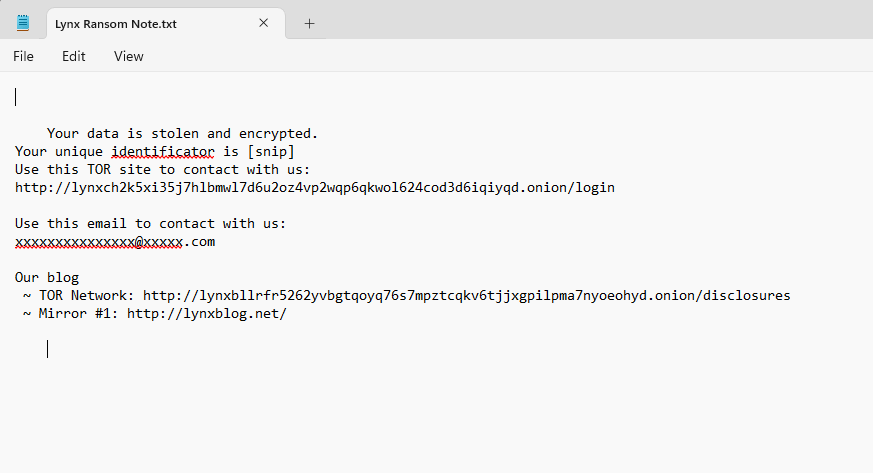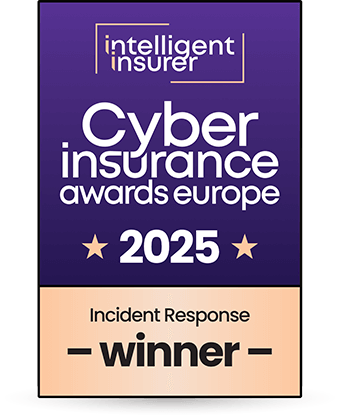An infection with Lynx ransomware typically results in locked systems and encrypted data, accompanied by a ransom demand - usually payable in cryptocurrency - to regain access and prevent the public release of sensitive information.
A break-in at your offices would compel you to call the police and touch nothing until they arrive, understanding the need for forensic work to take place.
A cyber-attack requires the same action. Your first responsibility is to call in the forensic experts and ensure the environment remains untouched.
This is not a job for your IT team or MSP. There are Digital Forensic specialists available 24/7 who can assist you.


Lynx first emerged in 2024 and has quickly gained attention due to its stealthy operations and tailored attack methods. Unlike some ransomware-as-a-service (RaaS) models, Lynx appears to operate as a closed group, targeting high-value organisations and government-related infrastructure.
The group is known to exploit both Windows and Linux environments. Common entry points include phishing campaigns, brute-force attacks on remote desktop protocol (RDP), and the exploitation of unpatched vulnerabilities in public-facing systems. Once access is obtained, Lynx exfiltrates data before encrypting files - employing a double extortion model to increase the pressure on victims.
In several known cases, Lynx has customised its ransom notes and leak threats depending on the victim’s industry or geographical location, suggesting a highly targeted and adaptive approach. Due to its stealthy and focused approach, the full scope of Lynx’s operations may not yet be known. However, cyber security analysts have noted its growing activity and are actively monitoring the group’s evolving tactics and infrastructure.
Lynx operates under a double extortion strategy - encrypting the victim’s data while also stealing it, then threatening to leak that data if the ransom isn’t paid. This tactic significantly increases the risk for victims, as the consequences extend beyond data loss to include reputational damage and regulatory penalties.
In some cases, Lynx has also used social engineering tactics, reaching out to victims directly via email or even phone to demand payment and provide ‘proof’ of data exfiltration. This level of engagement suggests a hands-on, calculated method of coercion rather than bulk, automated attacks.
Lynx was first observed in the wild in early 2024. While still a relatively new player in the ransomware landscape, it has claimed 290 victims in sectors such as manufacturing, legal services, and municipal government.
Solace Cyber’s track record includes hundreds of successful response recoveries, providing Digital Forensic Incident Response services, 24x7x365.
“Formal incident response plans are not widespread. Only 22% of businesses and 19% of charities have them.”

Solace Global was founded in 2010 as global experts in risk management and security, offering services such as Travel, Crisis, and Offshore Risk Management. With a 24/7 Security Operations Centre and an in-house intelligence team providing daily and weekly reports, Solace Global is accredited to ISO 27001, 14001, 45001, and 9001 standards.
Solace Cyber was established in 2021, specialising in Cyber breaches, particularly Digital Forensics and Incident Response, Ransomware, Risk Management, and Information Security, along with Managed Security Services. The leadership team collectively possess over 20 years of experience in the IT and security industry. Solace Cyber is accredited to ISO 27001.
s
%+
A forensic analysis needs to be meticulous and a clean restore and recovery requires a wealth of experience not normally available in an in-house team who must provide a broader range of IT support skills:


Solace Cyber was established precisely for this scenario. We have a well-defined process for handling cyber-attacks like Lynx, which involves a 6-step approach:
It includes a thorough digital forensic analysis from step 2 where the output becomes a central component of business recovery. This is because understanding the attack is of critical importance:
It is critical that the analysis of digital evidence is carried out to an agreed plan. This will have been designed to provide the best and earliest chance of discovering a root cause, which is essential to inform remediation/eradication and recovery as well as supporting a legal take-down case if this is applicable. A legal take-down means we can assist in the legal enforcement that stops the criminals from publishing the data, thus undermining the ransom notice.
Solace’s Digital Forensic and Incident Response teams maintain consistent communication throughout. Dedicated Incident Managers and technical engineering leads provide updates during the Cyber Incident Response journey, utilising risk registers and working within change management processes, all from triage through to post-incident, delivering successful business recovery.
Solace Cybers' assistance extends beyond recovery. After restoring your business operations, we work collaboratively to ensure your cyber security posture is robust using a threat-informed methodology. This involves leveraging our comprehensive 9-step framework known as the Solace Global - Cyber 9 Step Process.
A Lynx ransomware attack generally enters a system in one of the following ways:
We recommend you adopt policies to:
After recovering from Lynx Solace Cyber recommends that you update your business continuity plan to account for lessons learnt during this attack & recovery.
The average cost of ransomware breaches hover around £500K, while smaller email data breaches typically incur expenses of around £50K. A critical decision emerges between preserving the environment for forensic analysis or opting for swift recovery to minimise business disruption. Delays in identifying and resolving breaches only exacerbate costs.
Cybersecurity insurance claims entail a multifaceted process, encompassing reasonable expenditures for investigation and remediation, alongside coverage for legal, business interruption, criminal liability, employment liability, and ransom policies. While the insurance industry plays a pivotal role in facilitating business recovery, cyber insurance is perceived as volatile within the sector, and many policies require meticulous validation.
Facing genuine pressure, there's a crucial decision to make - one that could rescue your organisation from weeks of operational standstill, reputation damage, and client data loss. Yet, the probability of a favourable outcome remains slim, emphasising the importance of engaging a specialised ransomware incident response team. They are your most viable recourse for navigating a ransomware incident.
The NCSC have documented the deliberations for paying ransomware: https://www.ncsc.gov.uk/ransomware/home
Important Reminder: It is a criminal offense to pay money to people who are subject to financial sanctions. The list of who is subject to financial sanctions is constantly changing.
The latest iteration can be found here: https://www.gov.uk/government/publications/financial-sanctions-consolidated-list-of-targets
Yes. There's a possibility that some of the lost data contains "Personal Data" belonging to your customers. Safeguarding such data is a legal requirement, so it's important to consider notifying the Information Commissioner's Office (ICO) about this incident, as well as your customers. https://ico.org.uk/
Your insurer or legal counsel will provide guidance on the necessary steps and how to proceed in this matter. However, Solace Cyber has experience collaborating with insurers and legal representatives and can offer assistance in managing these relationships during this challenging period.
Your business operations may experience significant disruptions. These could include:
To mitigate these effects, it's crucial to have a comprehensive incident response plan in place, including communication strategies, collaboration with cybersecurity experts, and measures to enhance system resilience and data protection. Additionally, transparency with stakeholders and proactive steps to rebuild trust can help minimize the long-term consequences on your business.
Action Fraud is the UK’s national reporting centre for fraud and cybercrime. Whether you have been scammed, defrauded, or experienced cybercrime in England, Wales, or Northern Ireland, Action Fraud offers a central point of contact for information on fraud and financially motivated cybercrime.
If your systems are showing signs of an Lynx attack, REMAIN CALM.
YOU MUST NOT TOUCH THEM, RESTORE OR OVERWRITE THE DATA (explanation above).
Contact Solace Cyber on 01202 308818 or complete our form for a call back from one of our experts.
We will act promptly to reduce your business downtime.

Solace Cyber, part of Solace Global, helps companies across the UK recover from ransomware attacks and data breaches.
SOLACE GLOBAL CYBER LTD is registered in England & Wales no. 08830710

Solace Global
Twin Sails House,
W Quay Rd,
Poole, BH15 1JF
United Kingdom